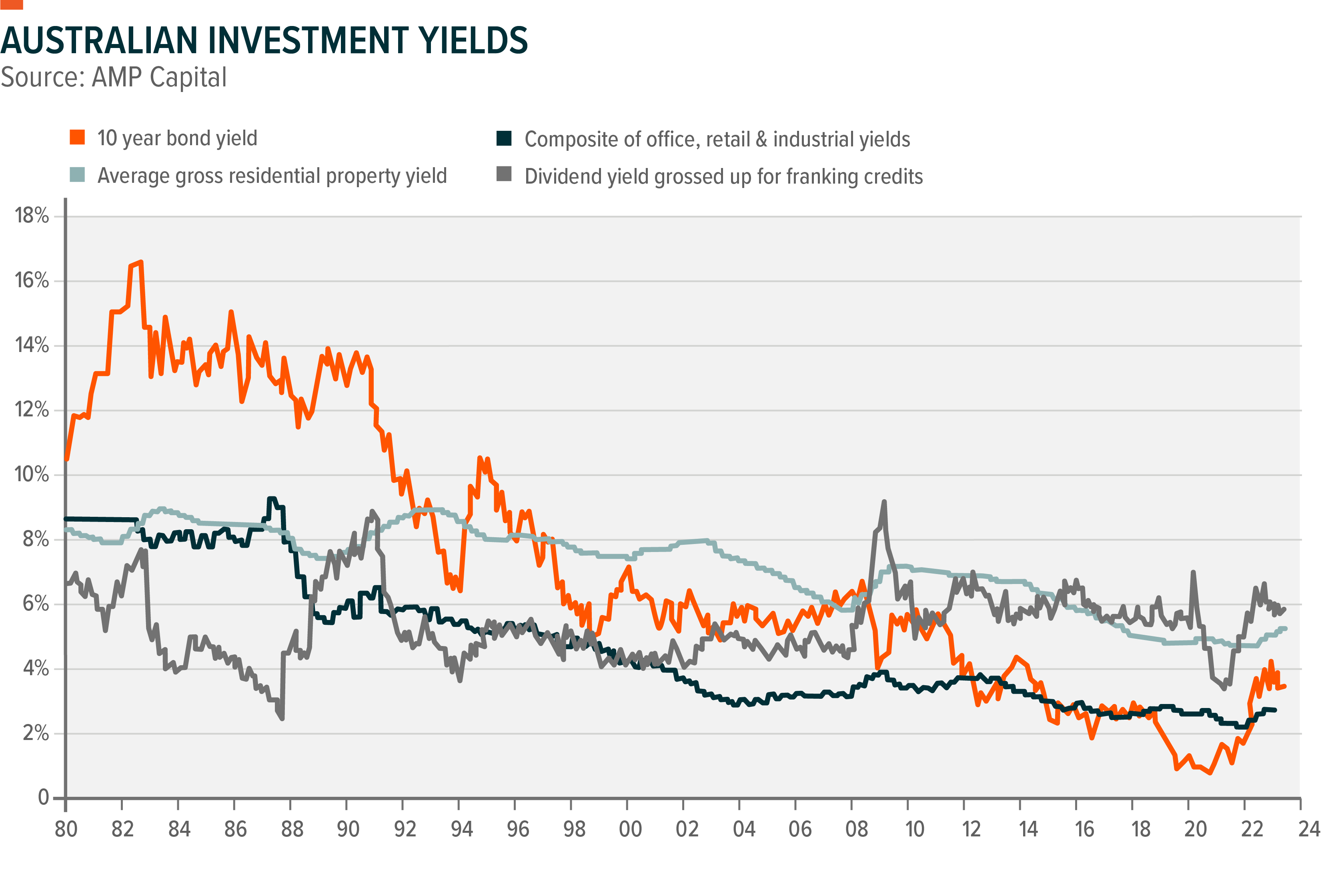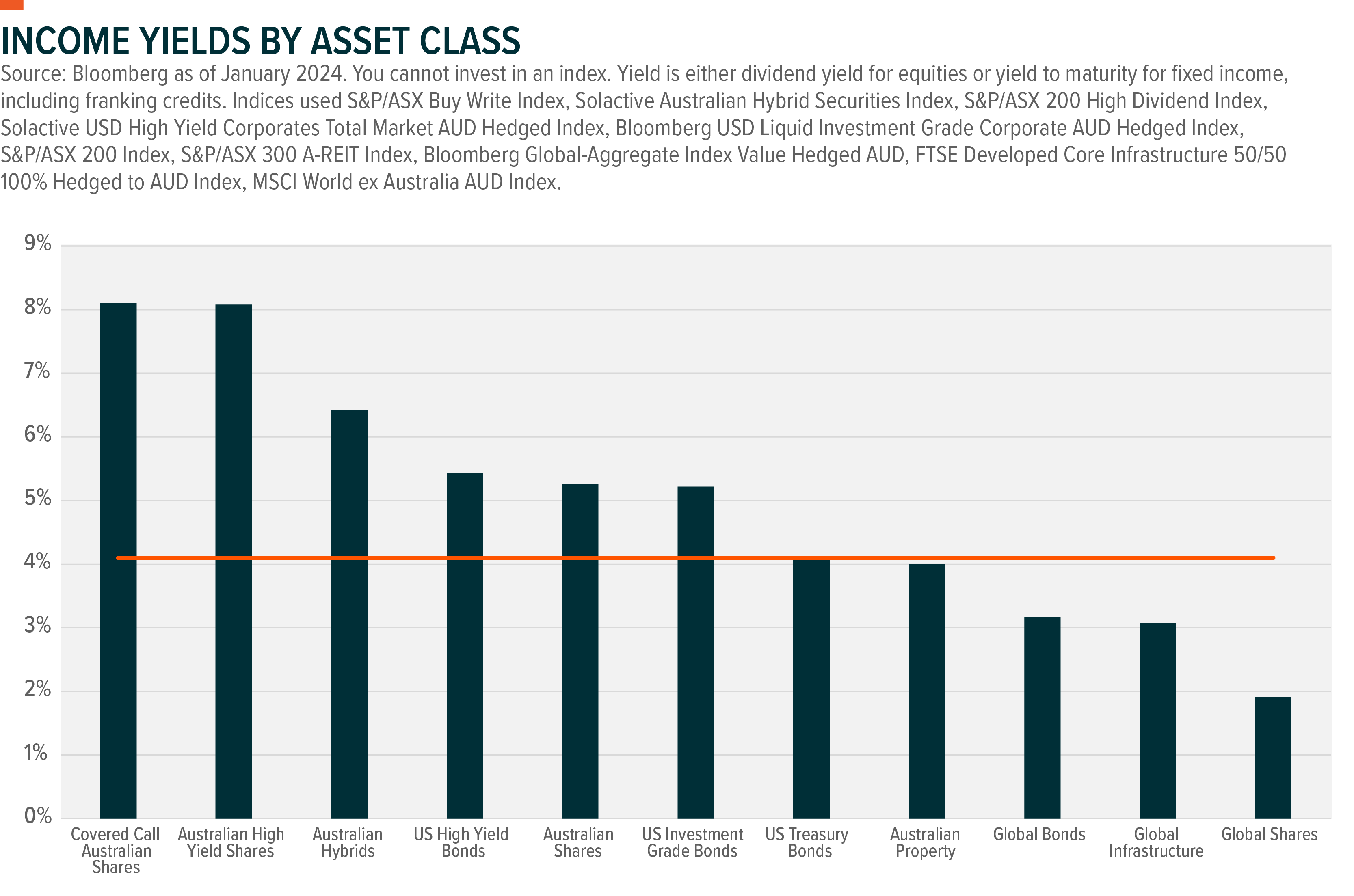How to optimise portfolio income
When building a portfolio, investors should consider their financial goals and risk profile. However, some investors may not have a distinct goal but just want to know they have enough to meet their cash flow needs. This is where income investing comes in – a key focus of investing in income-producing assets to provide a steady stream of cash flow. Income is an important component in helping clients achieve their desired goals. But how does one build an income investing strategy?
Why turn to income?
The golden days of income investing in Australia were relatively straightforward in the 1980s where local term deposits and Australian residential properties were yielding around 14% p.a. and 8% p.a. respectively. However, income yields have compressed over the last 40 years and the start of the 2020’s decade pose some new dynamics for investors, as illustrated below. This has led to investors, particularly those focused on income and capital stability, searching for attractive yields through other means.

Having a diversified mix of income producing assets avoids the concentration of putting all your eggs into one basket. Diversification is a key tenant of income investing as investors can generate multiple sources of income from different assets (like shares and bonds) and regions (such as Australia and abroad).
As investors search for yield, they can sometimes make the mistake of gravitating towards risky assets. Investing for income in evidence-based investment strategies can help add a layer of risk mitigation and cushion the downside. For example, the income generated from an investment portfolio can help act as a buffer if asset prices fall. Dividend paying companies are normally resilient and have strong balance sheets that can navigate periods of market stress, while option-based strategies can generate high yields and simultaneously outperform during down or sideways markets.
How to use income investing in a portfolio
Investors first need to understand their objectives, risk tolerance, risk capacity and time horizon before deciding which income-producing assets to invest in. This will help determine the universe of income producing assets to explore and the diversification mix required. A well-balanced income portfolio contributes to yield generation, diversification, and volatility reduction.
From there, investors can determine a considerable mix of risk and income necessity. Those who rely on income to fund their lifestyle may choose an income strategy to be the core part of their portfolio, like Australian high-dividend paying shares. If income is more important than capital growth, or share markets are volatile, covered-call strategies can help navigate the uncertainty and provide enhanced levels of income.

It’s also important for investors to blend the growth part of their portfolio with defensive income through the use of bonds. These pay fixed income on a regular basis and can also add a level of ballast to portfolios in case the income producing shares fall in price. Growth assets like covered calls also have defensive characteristics as they can help cushion portfolio drawdowns through the options premium income generated.
For investors who don’t need to rely on income as the core of their portfolio, but would like to enhance their overall yield profile, they can use income producing assets as a building block in the core of their portfolio. This could involve allocating new money or rotating a small part of the portfolio into income producing strategies. These satellite exposures can add diversification benefits, higher income levels and not overburden the core focus of the investing strategy.
Who could benefit?
Income investing can suit a range of investor types1:
- Retirees who want to ensure they can meet their living expenses and enjoy their golden years may prioritise income investing strategies. If they have built up a nice nest egg of capital over the years, this could be used as a principal investment into income producing assets to provide a steady stream of passive income.
- Investors who prefer lower risk and greater predictability may also benefit from an income investing portfolio. The investing marketplace can be full of unpredictable changes driven by central bank policy, share market volatility or other nasty surprises that can impact asset prices. Some income strategies can have lower volatility and a greater reliability of providing yield even during tough times.
- Finally, those who are not able to increase their wages to keep up with inflation may look to supplement their earnings with a portfolio of income enhancing investments. Household earnings, after taking into account inflation (known as real wages), have experienced one of the sharpest decreases in history. This places a strong emphasis on finding ways to fill the gap in income and to preserve purchasing power over time, of which an income investing strategy can potentially solve.
The role of income ETFs
Income ETFs serve as a valuable component in investors’ portfolios, offering convenience, ease of implementation, diversification, cost-effectiveness, and simplicity. By holding a basket of securities according to specific index rules, ETFs inherently spread risk across multiple securities to provide a diversified income source.
For income-focused investors, ETFs are also attractive as they directly pass on generated income from the fund to unit holders, in contrast to other investment vehicles that may retain the income generated and use them for other portfolio management means.
ETFs are a favourable option for income investors seeking consistent returns and a steady stream of cash flow. Global X has a comprehensive suite of income investing solutions designed to help meet investor’s income goals and provide it in a low-cost and transparent wrapper – explore the products in more detail here.
Using an income investing strategy allows investors to cultivate a long-term portfolio, maximising income while maintaining a stable and diversified approach. This strategy can provide a set-and-forget solution to help meet certain financial and cash flow goals.

1 stock mentioned
1 fund mentioned

